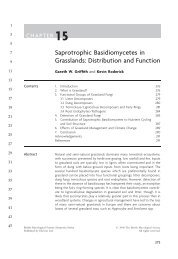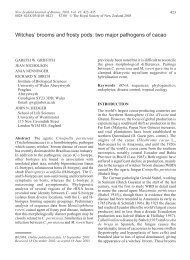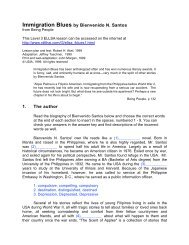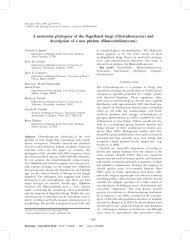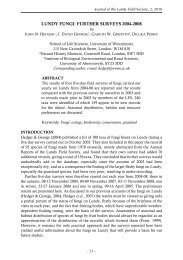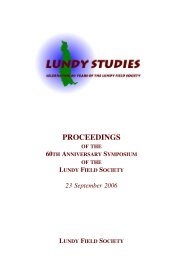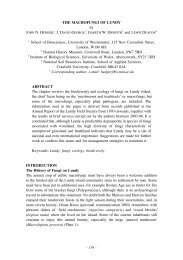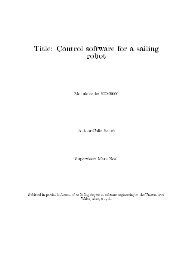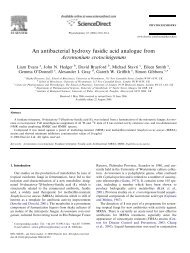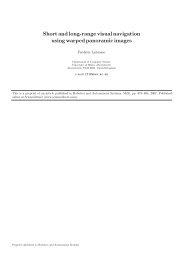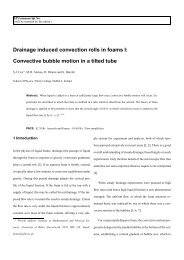Anaerobic rumen fungi
Anaerobic rumen fungi
Anaerobic rumen fungi
Create successful ePaper yourself
Turn your PDF publications into a flip-book with our unique Google optimized e-Paper software.
5. DISTRIBUTION IN NATURE<br />
<strong>Anaerobic</strong> <strong>fungi</strong> have been reported in all geographic regions of the world, being ubiquitous<br />
among fore-gut fermenters and ruminants such as cattle, buffalo, goat (Ho et al. 1993a; 1993c;<br />
Singhal, 2000; Thareja et al. 2006), red deer, impala (Bauchop, 1979) and wild Bluebull (Boselaphus<br />
tragocamelus) (Paul et al. 2004; Tripathi et al. 2007a) as well as marsupials including kangaroo,<br />
wallaroo and swamp wallaby (Breton et al. 1989). These <strong>fungi</strong> have also been isolated from faecal<br />
samples of the horse, zebra, donkey, rhinoceros and Indian elephant (Bauchop, 1983; Breton et al.<br />
1990; Li et al. 1990; Orpin, 1994; Theodorou et al. 1994), all being hindgut fermenters. Therefore,<br />
these <strong>fungi</strong> appear to be a standard constituent of the gut microflora in many herbivores fed on a<br />
highly fibrous diet.<br />
6. METABOLISM AND PHYSIOLOGY<br />
<strong>Anaerobic</strong> <strong>fungi</strong> derive energy by anaerobic fermentation of carbohydrates (Trinci et al. 1994). A<br />
large number of poly-, oligo-, and monosaccharides including glucose, cellobiose, fructose,<br />
maltose, sucrose and xylose, support their growth (Orpin, 1975, 1976; Mountfort and Asher, 1983;<br />
Phillips and Gordon, 1988). <strong>Anaerobic</strong> <strong>fungi</strong> follow a mixed-acid fermentation profile similar to<br />
enterobacteria such as E. coli with the conversion of hexose to acetate, formate, lactate, succinate,<br />
ethanol, CO 2 and H 2 (Borneman et al. 1989, Trinci et al. 1994). These products may fluctuate among<br />
different genera i.e. high malate and lactate by Anaeromyces spp. compared to Orpinomyces<br />
(Phillips and Gordon, 1988). Table 3 shows the outline of cellulose fermentation by N. frontalis:<br />
Table 3. Fermentation of cellulose by N. frontalis (Bauchop and Mountfort, 1981).<br />
Fermentation product mol/ 100 mol hexose<br />
Acetate<br />
72.7<br />
Lactate<br />
67.0<br />
Ethanol<br />
37.4<br />
Formate<br />
83.1<br />
Carbon dioxide<br />
37.6<br />
Hydrogen<br />
35.3<br />
Methane 0.0<br />
ANAEROBIC RUMEN FUNGI<br />
<strong>Anaerobic</strong> <strong>fungi</strong> lack mitochondria, cytochromes and other biochemical features of the<br />
oxidative phosphorylation pathway. In cytosol, all major enzymes required for glycolysis<br />
through the Embden-Meyerhof-Parnas pathway are present while glucose-6-phosphate<br />
dehydrogenase and the other enzymes of Entner-Dodouroff pathway are absent (Yarlett et al.<br />
1986; O'Fallon et al. 1991; Marvin-Sikkema et al. 1993). The group possesses organelles<br />
(hydrogenosomes) for a major part of anaerobic energy metabolism (Muller, 1993; Trinci et al.<br />
1994; Benchimol et al. 1996). Hydrogenosomes are spherical double-membrane bound redox<br />
organelles (0.2 – 1 µm), and have been reported in phylogenetically distant amitochondriate<br />
eukaryotes that inhabit anaerobic or microaerophilic environments (Muller, 1993).<br />
7. TRANSFER AND SURVIVAL BETWEEN DIFFERENT HOSTS<br />
<strong>Anaerobic</strong> <strong>fungi</strong> can be isolated from alimentary tracts of ruminants (Davies et al. 1990, 1993)<br />
and propagules survive in air-dried faeces up to 10 months (Milne et al. 1989; Theodorou et al.<br />
1990; McGranaghan et al. 1999). There have been attempts to identify putative aero-tolerant<br />
resting structures (Wubah et al., 1991b; Nielsen et al., 1995; Richardson et al., 1998), though only in<br />
a single unnamed Anaeromyces species have spores been unequivocally identified (Ozkose, 2001;<br />
379



